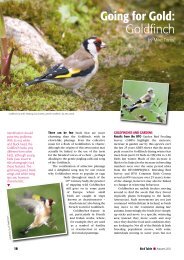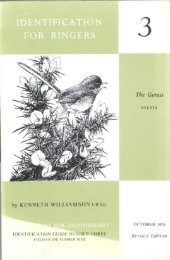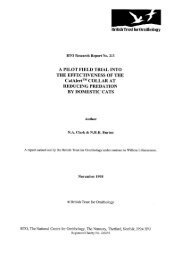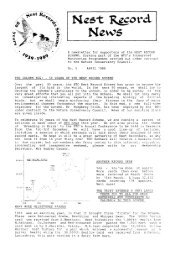Warbler - British Trust for Ornithology
Warbler - British Trust for Ornithology
Warbler - British Trust for Ornithology
Create successful ePaper yourself
Turn your PDF publications into a flip-book with our unique Google optimized e-Paper software.
INTRODUCTION 9<br />
wallis and Smith, 1960) gets under way, our knowledge in this<br />
field will increase. Meanwhile, it will be clear from the little<br />
in<strong>for</strong>mation available <strong>for</strong> most species that a full statement will<br />
not be possible <strong>for</strong> many years to come-indeed, perhaps not<br />
until trapping and ringing in Africa, India and S.E. Asia tmdergo<br />
a similar revolution to that which is apparent in Britain today.<br />
<strong>British</strong> <strong>Trust</strong> <strong>for</strong> <strong>Ornithology</strong> KENNETH WILLIAMSON<br />
(Migration Research Officer)<br />
PREFACE TO THE SECOND EDITION<br />
IN REVISING Identification <strong>for</strong> Ringers no. 1 the opportunity has been<br />
taken to enlarge and re-cast the material so that this new edition<br />
will be more nearly a companion-volume to guide no. 2, which<br />
deals with the genus Phylloscopus.<br />
As in that guide, I have arranged the birds of the 'reed-marsh'<br />
group ofwarblers in accordance with primary plumage characters<br />
and size, and this has meant sinking two monotypic genera,<br />
Lusciniola and Phragamaticola. The genus Acrocephalus is a very<br />
varied one in so far as wing-<strong>for</strong>mula and structural characters are<br />
concerned, and I can see no grounds which seem to me to justify<br />
the separation ofthe Moustached <strong>Warbler</strong> melanopogon from the<br />
streaked members ofAcrocephalus in a genus of its own. Indeed,<br />
this almost traditional arrangement has tended to obscure the<br />
bird's true relationship, <strong>for</strong> Dresser (1902), Hartert (1910), The<br />
Handbook of <strong>British</strong> Birds (1938) and many other works interpose<br />
the genus Locustella between the Moustached and the closely<br />
similar Sedge- and Aquatic <strong>Warbler</strong>s. Colin Harrison and Shane<br />
Parker, working independently on this group at the <strong>British</strong><br />
Museum (Natural History), hold similar views, and recommend<br />
that Lusciniola should be synonymized with Acrocephalus (Bull.<br />
RO.C., in press).<br />
There might be more justification <strong>for</strong> upholding the monotypic<br />
genus Phragamaticola, in view ofthe Thick-billed <strong>Warbler</strong>'s<br />
exceptionally rounded wing, long rounded tail, and short bill;







